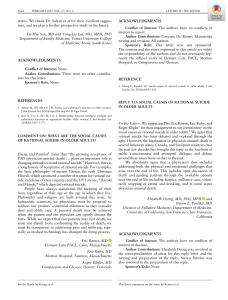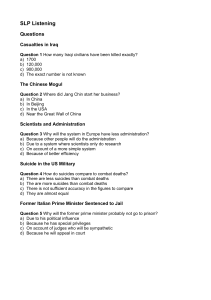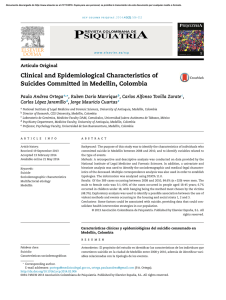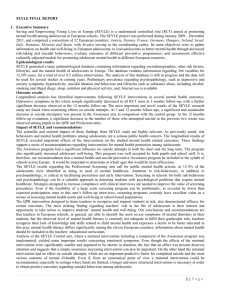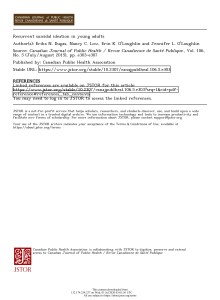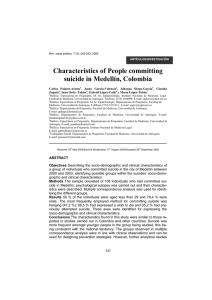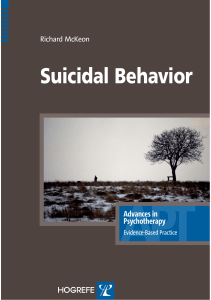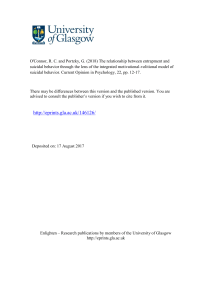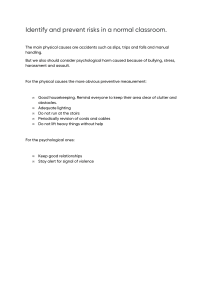Suicidal Behavior: Psychology, Risk Factors, and Interventions
Anuncio
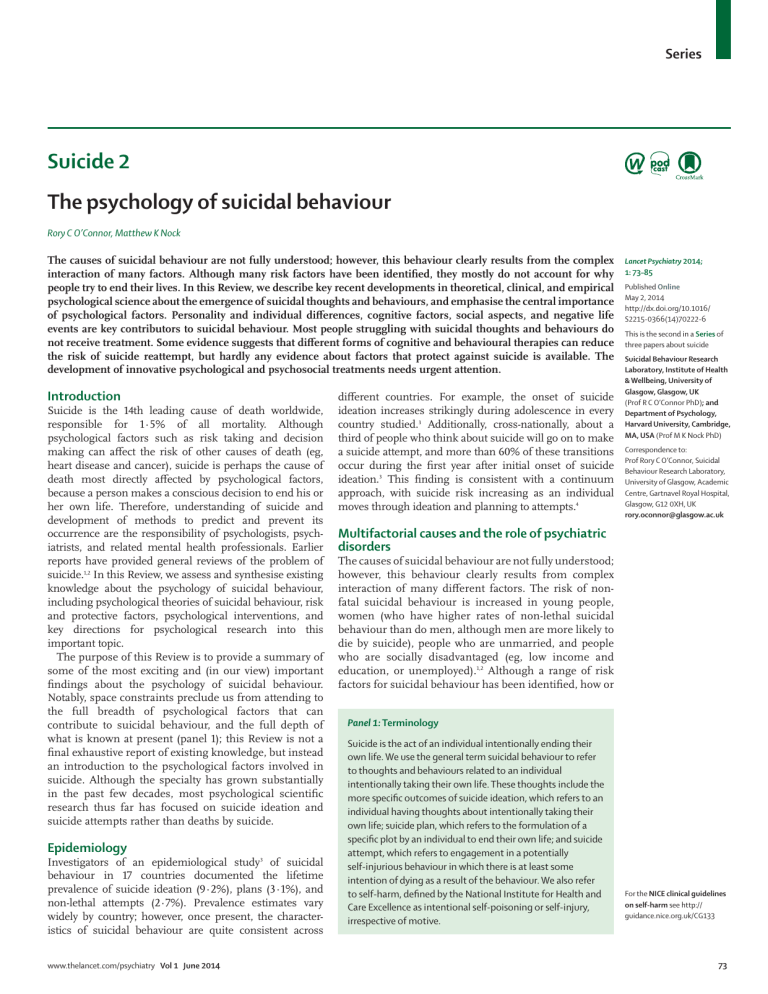
Series Suicide 2 The psychology of suicidal behaviour Rory C O’Connor, Matthew K Nock The causes of suicidal behaviour are not fully understood; however, this behaviour clearly results from the complex interaction of many factors. Although many risk factors have been identified, they mostly do not account for why people try to end their lives. In this Review, we describe key recent developments in theoretical, clinical, and empirical psychological science about the emergence of suicidal thoughts and behaviours, and emphasise the central importance of psychological factors. Personality and individual differences, cognitive factors, social aspects, and negative life events are key contributors to suicidal behaviour. Most people struggling with suicidal thoughts and behaviours do not receive treatment. Some evidence suggests that different forms of cognitive and behavioural therapies can reduce the risk of suicide reattempt, but hardly any evidence about factors that protect against suicide is available. The development of innovative psychological and psychosocial treatments needs urgent attention. Introduction Suicide is the 14th leading cause of death worldwide, responsible for 1·5% of all mortality. Although psychological factors such as risk taking and decision making can affect the risk of other causes of death (eg, heart disease and cancer), suicide is perhaps the cause of death most directly affected by psychological factors, because a person makes a conscious decision to end his or her own life. Therefore, understanding of suicide and development of methods to predict and prevent its occurrence are the responsibility of psychologists, psychiatrists, and related mental health professionals. Earlier reports have provided general reviews of the problem of suicide.1,2 In this Review, we assess and synthesise existing knowledge about the psychology of suicidal behaviour, including psychological theories of suicidal behaviour, risk and protective factors, psychological interventions, and key directions for psychological research into this important topic. The purpose of this Review is to provide a summary of some of the most exciting and (in our view) important findings about the psychology of suicidal behaviour. Notably, space constraints preclude us from attending to the full breadth of psychological factors that can contribute to suicidal behaviour, and the full depth of what is known at present (panel 1); this Review is not a final exhaustive report of existing knowledge, but instead an introduction to the psychological factors involved in suicide. Although the specialty has grown substantially in the past few decades, most psychological scientific research thus far has focused on suicide ideation and suicide attempts rather than deaths by suicide. Epidemiology Investigators of an epidemiological study3 of suicidal behaviour in 17 countries documented the lifetime prevalence of suicide ideation (9·2%), plans (3·1%), and non-lethal attempts (2·7%). Prevalence estimates vary widely by country; however, once present, the characteristics of suicidal behaviour are quite consistent across www.thelancet.com/psychiatry Vol 1 June 2014 different countries. For example, the onset of suicide ideation increases strikingly during adolescence in every country studied.3 Additionally, cross-nationally, about a third of people who think about suicide will go on to make a suicide attempt, and more than 60% of these transitions occur during the first year after initial onset of suicide ideation.3 This finding is consistent with a continuum approach, with suicide risk increasing as an individual moves through ideation and planning to attempts.4 Lancet Psychiatry 2014; 1: 73–85 Published Online May 2, 2014 http://dx.doi.org/10.1016/ S2215-0366(14)70222-6 This is the second in a Series of three papers about suicide Suicidal Behaviour Research Laboratory, Institute of Health & Wellbeing, University of Glasgow, Glasgow, UK (Prof R C O’Connor PhD); and Department of Psychology, Harvard University, Cambridge, MA, USA (Prof M K Nock PhD) Correspondence to: Prof Rory C O’Connor, Suicidal Behaviour Research Laboratory, University of Glasgow, Academic Centre, Gartnavel Royal Hospital, Glasgow, G12 0XH, UK [email protected] Multifactorial causes and the role of psychiatric disorders The causes of suicidal behaviour are not fully understood; however, this behaviour clearly results from complex interaction of many different factors. The risk of nonfatal suicidal behaviour is increased in young people, women (who have higher rates of non-lethal suicidal behaviour than do men, although men are more likely to die by suicide), people who are unmarried, and people who are socially disadvantaged (eg, low income and education, or unemployed).1,2 Although a range of risk factors for suicidal behaviour has been identified, how or Panel 1: Terminology Suicide is the act of an individual intentionally ending their own life. We use the general term suicidal behaviour to refer to thoughts and behaviours related to an individual intentionally taking their own life. These thoughts include the more specific outcomes of suicide ideation, which refers to an individual having thoughts about intentionally taking their own life; suicide plan, which refers to the formulation of a specific plot by an individual to end their own life; and suicide attempt, which refers to engagement in a potentially self-injurious behaviour in which there is at least some intention of dying as a result of the behaviour. We also refer to self-harm, defined by the National Institute for Health and Care Excellence as intentional self-poisoning or self-injury, irrespective of motive. For the NICE clinical guidelines on self-harm see http:// guidance.nice.org.uk/CG133 73 Series why these factors work together to increase the risk of this behaviour is not clear. Perhaps the most widely studied risk factor for suicidal behaviour is the presence of a previous psychiatric disorder. Findings from psychological autopsy studies5 suggest that more than 90% of people who die by suicide have a psychiatric disorder before their death. On balance, however, most people with a psychiatric disorder never become suicidal (ie, experience suicidal thoughts, make suicide attempts, or die by suicide). For instance, less than 5% of people admitted to hospital for treatment of an affective disorder die by suicide;6 most people with a psychiatric disorder will not die by suicide, nor will they experience suicidal behaviour. Thus, although the presence and accumulation of psychiatric disorders are risk factors for suicidal behaviour, they have little predictive power, and perhaps more importantly do not account for why people try to kill themselves. For this reason, more specific markers of suicide risk need to be identified. Psychological science is well placed to advance the understanding of why some people attempt suicide but others do not. Understanding of the psychological processes that underpin both suicidal ideation and the decision to act on suicidal thoughts is particularly important, because interventions should be targeted at addressing suicidal ideation when it first emerges, before it progresses to a suicide attempt. Psychological theories of suicidal behaviour The origins of recent theories can be traced back to Freud, although sustained research into suicide did not begin in earnest until the 1950s, and has grown substantially in the past 25 years.7,8 Contemporary models of suicide are mostly diathesis stress in origin and cognitive in focus (table).8,11,12,14,15,19 Diathesis–stress models posit that the negative results of pre-existing vulnerability factors are especially pronounced when activated by stress. Schotte and Clum10 and Mann and colleagues12 have promoted the diathesis–stress perspectives. Recent cognitive and behavioural models have also guided treatment developments.13,17 Linehan’s model of emotion dysregulation, originally developed in the context of borderline personality disorder, underpins dialectical behaviour therapy,20 whereas other theoretical developments have focused on an individual’s appraisal system.16 Psychological theories are important theoretically and clinically because they provide a framework to understand how a complex interplay of factors combine to increase risk of suicide. Additionally, these theories help to identify potentially modifiable targets for treatment. Although earlier theories focused on individual psychological factors,11,21 they did not account for why most people who have thoughts of suicide do not attempt suicide.3 In view of the clinical importance of being able to make predictions about the transitions to suicidal Author Basic premise Cubic model of suicide Shneidman (1985)9 The combination of press (stress), pain (psychache), and perturbation result in suicide risk Diathesis–stress–hopelessness model of suicidal behaviour Schotte and Clum (1987)10 Cognitive vulnerability (eg, social problem solving) accounts for the association between stress and suicide risk Suicide as escape from self Baumeister (1990)11 Main motivation of suicide is to escape from painful self-awareness Clinical model of suicidal behaviour Mann and colleagues (1999)12 Stress–diathesis model, wherein suicide risk is caused not only by psychiatric disorder (stressor) but also by a diathesis (ie, tendency to experience more suicidal ideation or impulsivity) Suicidal mode as cognitive behavioural Rudd and colleagues (2001)13 model of suicidality Based on the ten principles of cognitive theory, the model describes the cognitive, affective, behavioural, and physiological system characteristics associated with the development of suicide risk Arrested flight model Williams (2001)14 Suicide risk is increased when feelings of defeat and entrapment are high and the potential for rescue (eg, social support) is low Interpersonal-psychological model Joiner (2005)15 Suicidal desire is caused by high levels of burdensomeness, and thwarted belongingness; desire is probably translated into suicidal behaviour when capability is high Schematic appraisal model of suicide Johnson and colleagues (2008)16 An appraisal model which proposes that risk is caused by the interplay between biases in information processing, schema, and appraisal systems Cognitive model of suicidal behaviour Wenzel and Beck (2008)17 Diathesis–stress model with three main constructs: dispositional vulnerability factors, cognitive processes associated with psychiatric disturbance, and cognitive processes associated with suicidal acts Differential activation theory of suicidality Williams and colleagues (2008)18 Associative network model, in which the experience of suicidal ideation or behaviour during a depressive episode increases the likelihood that it will re-emerge during subsequent episodes Integrated motivational-volitional model of suicidal behaviour O’Connor (2011)8 The model is a diathesis–stress model, which specifies the components of the premotivational, motivational (ideation and intent formation), and volitional (behavioural enaction) phases of suicidality Table adapted from O’Connor8 by permission of John Wiley & Sons. Table: Predominant models of suicidal behaviour 74 www.thelancet.com/psychiatry Vol 1 June 2014 Series ideation and from suicidal ideation to attempt or death, we focus on two theories that do so. Indeed, understanding of this distinction is of crucial importance. First, Joiner’s15,22 interpersonal theory of suicide (figure 1) posits that the coexistence of high levels of perceived burdensomeness (ie, feeling a burden on others) and low levels of belongingness (ie, feeling alienated or that you do not belong), and being hopeless that these states will not change, lead to the development of suicidal desire (ie, suicidal ideation). Suicidal desire is a necessary though not sufficient cause for a suicide attempt. However, if a person with high suicidal desire acquires the capability to attempt suicide, then the risk of a serious suicide attempt is increased. Acquired capability comprises reduced fear of death and increased tolerance for physical pain. According to the theory, exposure to and encounter with previous painful experiences increase an individual’s tolerance for the physical-pain aspects of self-harm through habituation processes. The core components of the theory have attracted considerable research attention. Second, the integrated motivational-volitional model of suicidal behaviour8 conceptualises suicide as a behaviour (rather than a byproduct of mental disorders) that develops through motivational and volitional phases (figure 2). The motivational phase describes the factors that govern the development of suicidal ideation and intent, whereas the volitional phase outlines the factors that determine whether an individual attempts suicide. This model integrates the key factors from earlier theories into a detailed map of the suicidal process from thoughts to acts of suicide. Whereas belongingness and burdensomeness are paramount in the final common pathway to suicide in the interpersonal theory, feelings of defeat (ie, feeling defeated after triggering circumstances) and entrapment (ie, unable to escape from stressful, humiliating, or defeating circumstances) are posited to be of most importance within the integrated motivational-volitional model. When an individual feels both defeated and trapped, the likelihood that suicidal ideation will emerge increases when motivational moderators (eg, low levels of social support) are present. The integrated motivationalvolitional model draws on the pioneering research done by Williams14 and others into social-rank theory, the cryof-pain and arrested-flight hypotheses, the differentialactivation hypothesis, and the theory of planned behaviour.23–25 Whereas the interpersonal theory of suicide posits that acquired capability establishes behavioural enaction (ie, suicide attempts), it is just one of several (volitional phase) factors within the integrated motivational-volitional model posited to increase the likelihood of a suicide attempt. Such factors include exposure to the suicidal behaviour of others, impulsivity, and having access to the means of suicide. Although the integrated motivational-volitional model is new, empirical evidence supports its usefulness. www.thelancet.com/psychiatry Vol 1 June 2014 Thwarted belongingness I am alone Desire for suicide Perceived burdensomeness I am a burden Capability for suicide Lethal (or near-lethal) suicide attempts Figure 1: Interpersonal theory of suicide15,22 Figure reproduced from Van Orden and colleagues22 by permission of the American Psychological Association. Psychological risk and protective factors Classification The factors associated with suicide risk can be classified into four groups: personality and individual differences, cognitive factors, social factors, and negative life events (panel 2). In reviewing these factors, we summarise what is known to date, but do not exhaustively describe the potential mechanisms through which these factors might affect suicidal behaviour, which is an extremely important goal for future research. We selected these factors because they feature in the theoretical models, have received research attention in the literature, or are promising candidates for the future. Each of these factors might contribute to the emergence of suicide risk independently or together with other factors. Some of the factors are associated with the emergence of suicidal ideation, whereas others increase the likelihood that suicidal thoughts will be acted on. Personality and individual differences Factors related to personality and individual differences are of interest because they are fairly stable in adulthood, often have known biological bases, are affected by the environment, and affect cognition and emotion. Hopelessness Although hopelessness is usually operationalised as a state factor (ie, a factor that varies over time), we include it in this section to emphasise that it also has trait components (ie, components that are relatively stable over time),26 and future research should investigate the relative predictive usefulness of state versus trait hopelessness. Hopelessness, defined as pessimism for the future, is a strong predictor of all indices of suicidal ideation and behaviour.27–31 In a classic study, Beck and colleagues32 were able to predict 91% of all suicides from 75 Series Pre-motivational phase Background factors and triggering events Diathesis Motivational phase Ideation/intention formation Defeat and humiliation Volitional phase Behavioural enaction Entrapment Suicidal ideation and intent Suicidal behaviour + Threat-to-self moderators Motivational moderators Examples include social problem solving, coping, memory biases, and ruminative processes Examples include thwarted belongingness, burdensomeness, future thoughts, goals, norms, social support, and attitudes Volitional moderators Environment + Life events Examples include capability, impulsivity, implementation, intentions (planning), access to means, and imitation Figure 2: Integrated motivational-volitional model8 of suicidal behaviour Figure reproduced from O’Connor8 by permission of John Wiley & Sons. hopelessness scores in a 10-year prospective study of patients admitted to hospital with suicidal ideation. However, findings from a 12-year prospective Finnish study33 showed that when suicidal intent was compared with hopelessness (in a sample of 224 cases of attempted suicide), hopelessness was a non-significant predictor of suicide. More recently, in a small study34 of people who attempted suicide, hopelessness did not significantly predict future suicide attempts in a 4-year follow-up when past suicide-attempt history and entrapment were included in the analysis. These more recent mixed findings suggest that although hopelessness is important in the development of suicidal ideation (consistent with theoretical models), other factors might be more useful in the prediction of actual suicide attempts or deaths. Impulsivity Although impulsivity has been studied for decades, its association with suicide risk is not as consistent or as straightforward as originally thought, and its effect might be less direct.28,35 Findings from many studies3,36,37 have shown that self-reported impulsivity is associated with suicidal ideation, suicide attempts, and suicide deaths. The meaning of impulsivity is confused and needs resolution, with some studies operationalising it as novelty-seeking behaviour or having a short attention span, whereas other researchers define it as nonplanning or cognitive impulsivity.37 Other research emphasises the importance of differentiation between impulsivity as a trait versus a state construct.38 The evidence is also mixed regarding whether impulsivity is associated with the medical seriousness of the episode.39,40 Nonetheless, impulsivity should still be considered when risk of suicide or self-harm is assessed. It might not be important in all cases of suicide risk, but it is more likely to be evident in young people than in older people.2,41,42 Impulsivity can be useful to predict repeated suicide attempts in individuals with personality disorder.43 Impulsive aggression is associated with suicide 76 attempts.12,28 Negative urgency, defined as the degree to which a person acts rashly when distressed, also needs further research.44 Perfectionism Growing evidence suggests that perfectionism is associated with suicidal ideation and suicide attempts, although few prospective clinical studies have been done.45,46 Perfectionism can be defined in different ways and not all types are equally associated with suicide risk. One type, socially prescribed perfectionism (defined as the belief that other people [eg, family members] hold unrealistically high expectations of you47), is most consistently associated with suicidal thoughts and attempts, especially when these socially determined beliefs are internalised as self-criticism. Recent research suggests that the social dimensions of perfectionism increase suicide risk by promoting a sense of social disconnection,46 which is consistent with the integrated motivational-volitional model and interpersonal theory of suicide. In particular, perfectionistic beliefs can also interact with other factors (eg, negative life events, adversity, and cognitions) to impede recovery from a suicidal episode or increase risk of suicidal ideation and self-harm further.27,45,48 The big five personality dimensions: neuroticism, extroversion, agreeableness, openness to experience, and conscientiousness In general terms, high levels of neuroticism and low levels of extroversion are associated with suicidal ideation, attempts, and completions.49–52 However, exceptions exist; in an 18-year follow-up53 of patients with depression, neuroticism did not predict future suicide risk. The combined effects of high neuroticism and low extroversion might be stronger predictors of suicide than is neuroticism alone.54 The proposed interaction is consistent with predominant theories, suggesting that people who are more sensitive to distress (ie, high neuroticism) and are socially disconnected (ie, low www.thelancet.com/psychiatry Vol 1 June 2014 Series extroversion) are at increased risk of suicide. The findings for openness to experience, conscientiousness, and agreeableness are less consistent, and these constructs have been less frequently studied.49,55 Optimism and resilience Surprisingly few attempts have been made to investigate the direct or indirect association between trait optimism and suicidal ideation or attempts, and almost no longitudinal studies have been published. Some evidence, however, in college students suggests that people with high optimism have reduced risk of suicidal ideation or attempts when confronted with severely or moderately negative life events compared with people with low optimism.56 Low levels of optimism are associated with self-harm in adolescent girls.57 Optimism has also been shown to buffer the association between hopelessness and suicidal ideation.58 The protective effect of optimism has also been shown in a patient sample recruited from a primary care clinic.59 Although these findings are promising, the protective effect over time is largely unknown and needs future scrutiny. Despite research interest in resilience (defined as “qualities that enable one to thrive in the face of adversity”60), there is little evidence for its protective effect in the context of suicide risk. Some evidence suggests a protective effect of resilience on suicide ideation in military personnel,61 misusers of alcohol and illegal drugs, and prisoners,62 but its effect on suicide attempts or deaths by suicide is largely unknown. The validation of the suicide resilience inventory might stimulate more research into this topic.63 In view of the scarcity of research into protective factors, efforts have been made to identify factors that confer resilience by buffering against suicide risk in the face of adversity.64 Such studies have examined appraisals of stressful situations and self-appraisal, and their findings suggest that positive appraisals might buffer against the development of suicidal ideation.16,64 Cognitive factors In an attempt to understand how and why some people’s thought processes lead them to decide to end their lives, researchers have examined different cognitive processes that might be deficient or dysfunctional in suicidal people. Such research has identified several cognitive factors that seem to increase the risk of suicidal behaviour. Cognitive rigidity For decades, clinical and theoretical accounts have described suicidal people as being cognitively rigid or inflexible, leading to the conclusion that suicide is the only option. Findings from studies in which behavioural tests of cognitive rigidity are administered to suicide attempters and clinical controls have lent support to this notion. This rigidity was first reported in an early study by Neuringer,65 and has since been shown many times with www.thelancet.com/psychiatry Vol 1 June 2014 Panel 2: Key psychological risk and protective factors for suicidal ideation and suicidal behaviour Personality and individual differences • Hopelessness • Impulsivity • Perfectionism • Neuroticism and extroversion • Optimism • Resilience Cognitive factors • Cognitive rigidity • Rumination • Thought suppression • Autobiographical memory biases • Belongingness and burdensomeness • Fearlessness about injury and death • Pain insensitivity • Problem solving and coping • Agitation • Implicit associations • Attentional biases • Future thinking • Goal adjustment • Reasons for living • Defeat and entrapment Social factors • Social transmission • Modelling • Contagion • Assortative homophily • Exposure to deaths by suicide of others • Social isolation Negative life events • Childhood adversities • Traumatic life events during adulthood • Physical illness • Other interpersonal stressors • Psychophysiological stress response use of a range of neuropsychological measures of cognitive rigidity or flexibility, such as tests of set-shifting (ie, the ability to change thinking and behaviour in response to a changing environment).66 Findings from recent studies66,67 showed that this effect was not accounted for by the presence of depression, and that cognitive rigidity prospectively predicted suicidal thinking.67 Impaired decision making is also evident in suicide attempters.68,69 Rumination Rumination, which refers to repetitive focus on an individual’s own symptoms of distress, has been linked with suicidal thoughts and attempts. A review70 into the association between rumination and suicidal behaviour showed that findings from 10 of 11 studies examining 77 Series this association showed support for this link. A distinction has been noted between brooding rumination, in which a person dwells on his or her symptoms, and reflective pondering, in which a person contemplates the reasons for his or her symptoms and potential solutions, with brooding rumination being more strongly associated with suicidal thoughts and attempts.70–72 Rumination has also been associated with increased symptoms of depression, hopelessness, and impaired problem solving; an important aim for future research is to clarify how these factors might work together to increase the risk of suicidal behaviour. Thought suppression Thought suppression refers to attempts to intentionally stop thinking unwanted thoughts. During the past 25 years, Wegner and other researchers73,74 have reported that thought suppression paradoxically increases the frequency of specific unwanted thoughts, and might be a mechanism through which several forms of psychopathology develop. Findings from several studies75,76 showed that a tendency to suppress unwanted thoughts was associated with both suicidal ideation and attempts, and that thought suppression mediated the association between emotion reactivity and the occurrence of selfinjurious thoughts and behaviour.75 Autobiographical memory biases People who engage in suicidal behaviour have a decreased ability to recall specific autobiographical memories,77 which might in turn impair their ability to imagine the future and to engage in effective problem solving, thus increasing the likelihood of suicidal behaviour.78,79 Some evidence suggests that autobiographical memory biases result in part from previous abuse or from the presence of an affective disorder,80 and as such represent a potential mechanism through which abuse and affective disorders could lead to suicidal behaviour. Belongingness and burdensomeness Durkheim,81 Shneidman,21 and most recently Joiner15 have proposed that thwarted belongingness predisposes to the development of suicidal thoughts and behaviour. Consistent with these theories, lack of social connectedness and subjective perception of thwarted belongingness have been associated with suicide ideation82,83 and suicide attempts.84–86 A person’s perceptions that he or she is a burden to others is an independent predictor of suicide ideation in a range of samples, including older adults87 and people with chronic pain.88 Perceived burdensomeness also has been shown to mediate the association between perfectionism and suicide ideation,89 and to remain predictive of ideation even after controlling for factors such as depression and hopelessness.87 Consistent with the interpersonal theory of suicide, the interaction of 78 perceived thwarted belongingness and burdensomeness is predictive of suicide ideation, even after controlling for depressive symptoms.90 Fearlessness and pain insensitivity As suicidal behaviour often includes infliction of physical pain on the body, the association between suicide risk and both pain sensitivity or tolerance and fearlessness about death has been examined. Although almost all research into pain sensitivity has focused on non-suicidal self-injury, increased pain thresholds and tolerance have been reported in suicidal adolescents.91 More research is needed to establish whether changes in pain sensitivity are a cause or result of suicide ideation or behaviour; how these changes vary as a function of suicidal history and across the lifespan requires clarification. Research findings suggest that suicide attempters have higher fearlessness about injury and death than do non-suicidal controls, and that this difference might account for why men are more likely to die by suicide than are women.92,93 Problem solving and coping That people who attempt to kill themselves have difficulties with problem solving or coping is, perhaps, self-evident. Nevertheless, study findings have consistently shown a link between suicidal behaviour and deficits in both interpersonal problem solving and coping.94,95 In view of the cross-sectional nature of most studies into this topic, however, the direction of this association is not clear. Moreover, these associations seem to be mostly accounted for by the presence of depression.96 Agitation Agitation, which is often conceptualised as a state of anxious excitement or disinhibition, has been linked with suicidal behaviour in many studies.97 For instance, in a chart study98 of 76 patients who died by suicide during hospital admission, 79% had severe anxiety or agitation shortly before their death.98 Agitation has been hypothesised to be one potential mechanism through which bipolar disorder, medical illness, and the prescription of certain psychiatric medications might increase the risk of suicidal behaviour.99–101 Recent research suggests that agitation is especially predictive of suicide attempts among people who have high capability for suicide.102 Implicit associations People with a recent history of suicidal behaviour show an implicit mental association between death and the self.103 Findings from research103,104 using the implicit association test showed that this association distinguished suicide attempters from distressed non-attempters presenting for emergency psychiatric treatment (ie, suicide attempters responded more quickly [measured in milliseconds] when pairing stimuli related to death and self than they did www.thelancet.com/psychiatry Vol 1 June 2014 Series when pairing life and self), and perhaps more importantly, that this mental association with death predicted future suicide attempts better than did prediction of future suicide attempts by either clinicians or patients. Attentional biases People with a recent history of suicidal behaviour show greater attention to, or interference for, stimuli related to suicide (eg, suicide attempters take longer to name the colour of words related to suicide than they do for neutral or negative words),105–107 and this bias predicts future suicide attempts above and beyond other factors, including the presence of a mood disorder and prediction of future suicidal behaviour by either clinicians or patients.106 However, whether attentional bias and implicit associations result from or are causes of suicidal thoughts remains unclear. Future thinking and goal adjustment Since the 1990s, pessimism for the future (characterised by the absence of positive future thinking, rather than the presence of negative future thinking) has been associated with suicidal ideation and attempts.108 This effect of impaired positive future thinking is independent of depression.108–110 Future research should explore whether the association between positive future thinking and suicide attempts changes over time, and establish whether the content of positive future thinking affects the extent to which positive thoughts are protective. More detailed study of imagery111 and flashforwards (ie, images about acting out future suicide plans or being dead)112 also offer promise. Personal goal pursuit defines identity, and how people adjust when a goal becomes unattainable is known to affect wellbeing.113 Indeed, evidence suggests that suicide attempters who tend not to re-engage with new goals (in the face of existing unattainable goals) are at increased risk of readmission to hospital after self-harm, with this association being further affected by the extent of existing goal disengagement.114 Reasons for living Reasons for living have been studied extensively in the prediction of suicidal ideation and attempts, and have been incorporated into treatment protocols.7,115,116 Good evidence suggests that individuals with few reasons for living are at increased risk of suicidal thinking117 and attempts.118 Related to reasons for living, in a 10-year follow-up study,119 psychiatric outpatients who had a moderate-to-strong desire to die and little desire to live were at increased risk of suicide. Defeat and entrapment Defeat and entrapment have received substantial attention within social-rank theories of depression, scientific literature about arrested flight, and most recently in the integrated motivational-volitional model.14,24,120 The inability to escape from defeating or www.thelancet.com/psychiatry Vol 1 June 2014 stressful circumstances provides the setting conditions for the emergence of suicidal thoughts.8,14 Although defeat and entrapment are well established constructs within the psychopathology literature, their application within suicide research offers substantial promise. Indeed, both defeat and entrapment distinguish suicidal individuals from controls independently of depression and hopelessness, and both predict suicidal ideation and attempts over time.25,34,120,121 Entrapment has also been shown to predict repeated suicide attempts in a 4-year period beyond traditional risk markers for suicide.34 Social factors Suicide does not occur in a social vacuum. Family history of suicide increases risk of suicide; this effect is independent of familial history of mental disorder,122 and is thereby partly suggestive of a social transmission effect. Exposure to suicidal behaviour of family or friends is also associated with these behaviours in adolescents.123–125 Maternal suicidal behaviour could be more strongly associated with offspring suicidal behaviour than is paternal suicidal behaviour, and children are more likely to be affected by parental suicidal behaviour than are adolescents or adults.126 The effects of suicide bereavement on subsequent suicide risk are discussed in detail by Pitman and colleagues.127 Although psychological mechanisms (eg, modelling effects) need further empirical enquiry, depictions of suicide in the media can affect rates of suicide.128 The effect of the internet on suicidal behaviour needs further attention, because it might exert both negative (eg, discouraging help seeking) and positive (eg, source of support or signposting) effects.129 Indeed, study findings showed that almost 20% of adolescents reported that the internet or social networking sites influenced their decision to self-harm.130 Psychological processes (including contagion, imitation, suggestion, identification, social learning, and assortative homophily or susceptibility) are also implicated in the development of suicide clusters.131 Social isolation and the absence of social support are established correlates of suicide risk, and are important components of contemporary models of suicidal behaviour.25,132,133 Any assessment of suicide risk should, as a matter of course, assess the extent to which a vulnerable individual is socially isolated. For the Series paper by Pitman and colleagues see page 86 Negative life events Childhood adversities Many studies134,135 have documented a strong association between the occurrence of adverse life events during childhood (eg, physical, sexual, and emotional abuse; family violence; and parental illness, divorce, or death) and the subsequent experience of suicidal behaviour. These study findings showed a strong dose–response association between number of types of adversities and subsequent risk of suicide attempt.134,135 Sexual and physical abuse during childhood are especially strong risk 79 Series Panel 3: Key directions for future psychological research Understanding and prediction • Reach a consensus about terminology and phenomenology in respect of all self-injurious behaviours • More large-scale studies that test psychological models and risk factors to predict suicide attempt and death • Incorporation of psychological factors into national linkage databases and psychological autopsy studies • Improved understanding of factors that distinguish those who attempt suicide from those who think seriously about it and those who repeatedly attempt suicide • Integration of experimental, naturalistic, clinical, and non-clinical research findings • Comprehensive testing of psychological models of suicidal behaviour • Focus on psychological factors that protect against suicide • Better understanding of the psychology of method selection • More psychological science research in participants from across the lifespan, from different ethnic backgrounds and countries Intervention and prevention • More large and sufficiently powered clinical trials of psychological treatments to reduce suicidal ideation, attempts, and suicide • Development of more innovative brief psychosocial interventions (employing a range of delivery modalities) to reduce suicidal ideation, attempts, and suicide • Better understanding of how different types of media representation of suicide and self-harm increase risk of suicidal behaviour and suicide clusters • Improved understanding of the barriers to help-seeking • Integrating advances in psychological science into suicide prevention and intervention programmes • Development of public health interventions to promote resilience • Development of interventions which can be delivered in low-income and middle-income countries factors for both the onset and persistence of suicidal behaviour, and the risk of suicidal behaviour is particularly high during childhood and adolescence, with the association between childhood adversities and suicidal behaviour decreasing with age.135 Traumatic life events during adulthood Unfortunately, negative life events can affect wellbeing at any age, and traumatic events during adulthood (eg, physical or sexual abuse; death of a loved one; disasters or accidents; and exposure to war or other violence) can also increase the risk of subsequent suicidal behaviour.136,137 Study findings have shown a dose–response relationship between the number of types of adversities and risk of subsequent suicidal behaviour; again, physical and sexual abuse seem to convey the highest risk for both the onset and persistence of suicidal behaviour.136 Physical illness Physical illnesses have also been linked with suicidal behaviour. The presence and accumulation of physical illnesses (eg, heart disease, chronic pain, and respiratory disorders) are significantly associated with subsequent suicidal behaviour.138–140 The mechanism through which physical illness increases risk of suicidal behaviour is not 80 completely understood. Some study findings suggest that this association is attributable to the presence of depression,139 whereas other investigators have reported that this association remains even after controlling for mental disorders.138 Other interpersonal stressors Various types of interpersonal stressors can increase the risk of suicidal behaviour,141 even after controlling for effects of mental disorders.142 Interpersonal stressors can take various forms, and several different types of stressors have been linked with suicidal behaviour, including romantic problems, legal difficulties, loss of income,143 non-heterosexual orientation,144,145 and bullying and victimisation.146 Although the link between important negative life events and increased risk of suicidal behaviour is clear, the mechanism is not fully understood. Some investigators report that the association between negative life events and suicidal behaviour is mediated by the presence of mental disorders,145,146 whereas other study findings do not support this explanation.142 A psychophysiological mechanism probably underpins the association. Indeed, dysregulation of the hypothalamic–pituitary–adrenal axis is implicated in the suicidal process.147 However, the exact nature of the association is unclear, because evidence suggests that suicide risk is associated with abnormal concentrations of cortisol or a maladaptive cortisol response to stress. Moreover, most people experience negative life events of some kind at some point in their lives but do not engage in suicidal behaviour, emphasising the importance of considering how vulnerability factors and stress factors might interact to produce suicidal behaviour, as suggested by theoretical models. Psychological treatment Most people struggling with suicidal thoughts and behaviours (roughly 60%) do not receive treatment.148 The main reasons for not seeking help are low perceived need and the desire to handle the problem personally.148 Future research is needed to develop effective ways to connect people with suicidal thoughts and behaviours with effective treatments. Unfortunately, few well-established evidence-based treatments for suicidal behaviour are available, such as prevention programmes,149 pharmacological interventions,150 and psychological treatments.151 Treatments targeting depression have not been shown to reduce suicidal thoughts or behaviours.152 Some evidence suggests that specific forms of cognitive and behavioural therapy that target suicidal thoughts and behaviours directly can decrease the risk of suicide reattempt among people who have made a previous attempt. For example, clinical trials testing dialectical behaviour therapy (in patients with borderline personality disorder)153 and cognitive therapy (in recent suicide attempters)154 have lent support to the effectiveness of these treatments to reduce the rate of suicide reattempt compared with other www.thelancet.com/psychiatry Vol 1 June 2014 Series interventions. However, few replications have been done by independent research groups, and studies have yet to establish interventions that prevent people at risk from making an initial suicide attempt. Findings from a metaanalysis155 of cognitive behaviour therapies for suicidal behaviour showed a statistically significant effect of cognitive behavioural therapy to reduce the rate of suicide attempt; however, the investigators noted a publication bias in this topic, with a funnel plot of published studies centring close to zero, smaller studies reporting more positive effect sizes, and no published study findings showing negative effects for any intervention. Several new interventions also offer promise. The collaborative assessment and management of suicidality is a clinical intervention designed to enhance the therapeutic alliance and decrease the risk of suicidal behaviour.156 Safety-planning interventions, which include the identification of warning signs, coping strategies, and sources of support in addition to restriction of access to lethal means, are also receiving welcome attention.157 Treatment based on mentalisation has shown some promise to reduce self-harm in adolescents.158 The fact that most suicidal people do not receive treatment, and that little evidence is available for the effectiveness of the interventions received by those who do, emphasises the tremendous importance of future work to develop psychological treatments for people at risk of suicidal behaviour. The utility of the internet and smartphones in treatment delivery also requires close examination. Key directions for psychological research Despite substantial advances in understanding of the suicidal mind, much more psychological research is needed (panel 3). Studies of suicide should routinely incorporate psychological components, especially in the case of large-scale national-linkage studies of suicide and suicide attempts. Psychological autopsy studies, in which information is collected about the deceased person from several informants, have played a key part in understanding the risk factors for suicide.159 More sophisticated autopsy studies in the future should be set up to investigate psychological factors in more detail. Research efforts to distinguish between suicide ideators, suicide attempters, and repeated attempters should be prioritised, because understanding of the factors that enable or impede behavioural enactment will inform the development of intervention studies. Studies that use new technologies (eg, smartphones) and real-time data collection (eg, ecological momentary assessment) are essential in this regard. Focus on the differential effects of psychological factors of suicide risk as a function of age, culture, and ethnic origin should be increased. There is still a tendency to generalise findings from, for example, middle adulthood to older adult and adolescent populations. Researchers have also overrelied on self-report observational studies; multimethod www.thelancet.com/psychiatry Vol 1 June 2014 Search strategy and selection criteria We searched PsycINFO, PubMed, and Web of Knowledge for articles published between January, 2003, and January, 2014, with the terms “suicid*”, and “psycholog* or “personality” or “cognitive”. We used no language restrictions. We selected key papers from the identified publications on the basis of topic covered and quality of research. Within a topic area with many studies, we selected a study (or studies) suggestive of the evidence-base or included a study that described a key or new finding. In less well researched but new topics, key studies were selected. We supplemented these publications with earlier landmark papers and suggestions from reviewers. The studies covered a wide range of populations, many of which included participants with psychiatric disorders. approaches with an increased focus on basic-science experimental research will help uncover the mechanisms by which factors increase or reduce suicide risk. As the specialty develops, the testing of psychological theories of suicide risk should be the rule rather than the exception. Such programmatic testing of risk and protective factors will not only benefit researchers, but also assist clinicians in the translation of research into clinical practice. Although the physical availability (ie, access) to methods of suicide affects their use,160 not much is known about the psychological factors that affect selection of one method of suicide over another. Psychological suicidology is still dominated by research in populations in western Europe and the USA and Canada, despite the fact that 60% of the world’s suicides occur in Asia. The dearth of research into protective factors also needs to be addressed. Although the development and use of psychological treatments has grown somewhat,161 they are not well supported by evidence and most people who experience suicidal thoughts and behaviours do not seek them out. The barriers to help-seeking and the role of media (including social media) within the suicidal process also remain poorly understood; although media guidelines for the reporting of suicide exist, more empirical evidence about which aspects of reporting are most dangerous is needed. Finally, psychological science has much to offer to policy planners in the development and implementation of programmes for suicide prevention. Promising multicomponent intervention developments have been made in recent years,162 and further advancement is needed to combat this devastating public health problem. Contributors Both authors contributed equally to the preparation of this Series paper. Declaration of interests We declare that we have no competing interests. Acknowledgments MKN received funding support from the John D and Catherine T MacArthur Foundation. 81 Series References 1 Hawton K, van Heeringen K. Suicide. Lancet 2009; 373: 1372–81. 2 Hawton K, Saunders KE, O’Connor RC. Self-harm and suicide in adolescents. Lancet 2012; 379: 2373–82. 3 Nock MK, Borges G, Bromet EJ, et al. Cross-national prevalence and risk factors for suicidal ideation, plans and attempts. Br J Psychiatry 2008; 192: 98–105. 4 Nock MK, Borges G, Ono Y, eds. Suicide: Global perspectives from the WHO World Mental Health Surveys. Cambridge: Cambridge University Press, 2012. 5 Cavanagh JT, Carson AJ, Sharpe M, Lawrie SM. Psychological autopsy studies of suicide: a systematic review. Psychol Med 2003; 33: 395–405. 6 Bostwick JM, Pankratz VS. Affective disorders and suicide risk: a reexamination. Am J Psychiatry 2000; 157: 1925–32. 7 Ellis TE, Rutherford B. Cognition and suicide: two decades of progress. Int J Cogn Ther 2008; 1: 47–68. 8 O’Connor RC. Towards an integrated motivational–volitional model of suicidal behaviour. In: O’Connor RC, Platt S, Gordon J, eds. International handbook of suicide prevention: research, policy and practice. Chichester: John Wiley & Sons, 2011: 181–98. 9 Shneidman ES. Definition of suicide. Chichester: John Wiley & Sons, 1985. 10 Schotte DE, Clum GA. Problem-solving skills in suicidal psychiatric patients. J Consult Clin Psychol 1987; 55: 49–54. 11 Baumeister RF. Suicide as escape from self. Psychol Rev 1990; 97: 90–113. 12 Mann JJ, Waternaux C, Haas GL, Malone KM. Toward a clinical model of suicidal behavior in psychiatric patients. Am J Psychiatry 1999; 156: 181–89. 13 Rudd MD, Joiner T, Rajab MH. Treating suicidal behavior: an effective, time-limited approach. New York, NY: Guilford Press, 2001. 14 Williams JMG. The cry of pain. London: Penguin, 2001. 15 Joiner TE. Why people die by suicide. Boston, MA: Harvard University Press, 2005. 16 Johnson J, Gooding P, Tarrier N. Suicide risk in schizophrenia: explanatory models and clinical implications, The Schematic Appraisal Model of Suicide (SAMS). Psychol Psychother 2008; 81: 55–77. 17 Wenzel A, Beck AT. A cognitive model of suicidal behavior: theory and treatment. Appl Prev Psychol 2008; 12: 189–201. 18 Williams JMG, Van der Does AJW, Barnhofer T, Crane C, Segal ZS. Cognitive reactivity, suicidal ideation and future fluency: preliminary investigation of a differential activation theory of hopelessness/suicidality. Cognit Ther Res 2008; 32: 83–104. 19 Rudd MD. Fluid vulnerability theory: a cognitive approach to understanding the process of acute and chronic suicide risk. In: Ellis PT, ed. Cognition and suicide: theory, research and therapy. Washington, DC: American Psychological Association, 2006: 355–68. 20 Crowell SE, Beauchaine TP, Linehan MM. A biosocial developmental model of borderline personality: elaborating and extending Linehan’s theory. Psychol Bull 2009; 135: 495–510. 21 Shneidman ES. The suicidal mind. Oxford: Oxford University Press, 1996. 22 Van Orden KA, Witte TK, Cukrowicz KC, Braithwaite SR, Selby EA, Joiner TE Jr. The interpersonal theory of suicide. Psychol Rev 2010; 117: 575–600. 23 Price J, Sloman L, Gardner R Jr, Gilbert P, Rohde P. The social competition hypothesis of depression. Br J Psychiatry 1994; 164: 309–15. 24 Gilbert P, Allan S. The role of defeat and entrapment (arrested flight) in depression: an exploration of an evolutionary view. Psychol Med 1998; 28: 585–98. 25 O’Connor RC. Suicidal behaviour as a cry of pain: test of a psychological model. Arch Suicide Res 2003; 7: 297–308. 26 Young MA, Fogg LF, Scheftner W, Fawcett J, Akiskal H, Maser J. Stable trait components of hopelessness: baseline and sensitivity to depression. J Abnorm Psychol 1996; 105: 155–65. 27 Beevers CG, Miller IW. Perfectionism, cognitive bias, and hopelessness as prospective predictors of suicidal ideation. Suicide Life Threat Behav 2004; 34: 126–37. 28 Brezo J, Paris J, Turecki G. Personality traits as correlates of suicidal ideation, suicide attempts, and suicide completions: a systematic review. Acta Psychiatr Scand 2006; 113: 180–206. 82 29 30 31 32 33 34 35 36 37 38 39 40 41 42 43 44 45 46 47 48 49 50 51 Nock MK, Kazdin AE. Examination of affective, cognitive, and behavioral factors and suicide-related outcomes in children and young adolescents. J Clin Child Adolesc Psychol 2002; 31: 48–58. Joiner TE Jr, Brown JS, Wingate LR. The psychology and neurobiology of suicidal behavior. Annu Rev Psychol 2005; 56: 287–314. Hawton K, Sutton L, Haw C, Sinclair J, Harriss L. Suicide and attempted suicide in bipolar disorder: a systematic review of risk factors. J Clin Psychiatry 2005; 66: 693–704. Beck AT, Steer RA, Kovacs M, Garrison B. Hopelessness and eventual suicide: a 10-year prospective study of patients hospitalized with suicidal ideation. Am J Psychiatry 1985; 142: 559–63. Suominen K, Isometsä E, Ostamo A, Lönnqvist J. Level of suicidal intent predicts overall mortality and suicide after attempted suicide: a 12-year follow-up study. BMC Psychiatry 2004; 4: 11. O’Connor RC, Smyth R, Ferguson E, Ryan C, Williams JMG. Psychological processes and repeat suicidal behavior: a four-year prospective study. J Consult Clin Psychol 2013; 81: 1137–43. Watkins HB, Meyer TD. Is there an empirical link between impulsivity and suicidality in bipolar disorders? A review of the current literature and the potential psychological implications of the relationship. Bipolar Disord 2013; 15: 542–58. Giegling I, Olgiati P, Hartmann AM, et al. Personality and attempted suicide. Analysis of anger, aggression and impulsivity. J Psychiatr Res 2009; 43: 1262–71. Gvion Y, Apter A. Aggression, impulsivity, and suicide behavior: a review of the literature. Arch Suicide Res 2011; 15: 93–112. Bagge CL, Littlefield AK, Rosellini AJ, Coffey SF. Relations among behavioral and questionnaire measures of impulsivity in a sample of suicide attempters. Suicide Life Threat Behav 2013; 43: 460–67. Baca-García E, Diaz-Sastre C, Basurte E, et al. A prospective study of the paradoxical relationship between impulsivity and lethality of suicide attempts. J Clin Psychiatry 2001; 62: 560–64. Dumais A, Lesage AD, Lalovic A, et al. Is violent method of suicide a behavioral marker of lifetime aggression? Am J Psychiatry 2005; 162: 1375–78. McGirr A, Renaud J, Bureau A, Seguin M, Lesage A, Turecki G. Impulsive-aggressive behaviours and completed suicide across the life cycle: a predisposition for younger age of suicide. Psychol Med 2008; 38: 407–17. O’Connor RC, Rasmussen S, Hawton K. Distinguishing adolescents who think about self-harm from those who engage in self-harm. Br J Psychiatry 2012; 200: 330–35. Boisseau CL, Yen S, Markowitz JC, et al. Individuals with single versus multiple suicide attempts over 10 years of prospective follow-up. Compr Psychiatry 2013; 54: 238–42. Anestis MD, Joiner TE. Examining the role of emotion in suicidality: negative urgency as an amplifier of the relationship between components of the interpersonal-psychological theory of suicidal behavior and lifetime number of suicide attempts. J Affect Disord 2011; 129: 261–69. O’Connor RC. The relations between perfectionism and suicidality: a systematic review. Suicide Life Threat Behav 2007; 37: 698–714. Roxborough HM, Hewitt PL, Kaldas J, et al. Perfectionistic self-presentation, socially prescribed perfectionism, and suicide in youth: a test of the perfectionism social disconnection model. Suicide Life Threat Behav 2012; 42: 217–33. Hewitt PL, Flett GL. Perfectionism in the self and social contexts: conceptualization, assessment, and association with psychopathology. J Pers Soc Psychol 1991; 60: 456–70. O’Connor RC, Rasmussen S, Hawton K. Predicting depression, anxiety and self-harm in adolescents: the role of perfectionism and acute life stress. Behav Res Ther 2010; 48: 52–59. Blüml V, Kapusta ND, Doering S, Brähler E, Wagner B, Kersting A. Personality factors and suicide risk in a representative sample of the German general population. PLoS One 2013; 8: e76646. Batterham PJ, Christensen H. Longitudinal risk profiling for suicidal thoughts and behaviours in a community cohort using decision trees. J Affect Disord 2012; 142: 306–14. Fergusson DM, Woodward LJ, Horwood LJ. Risk factors and life processes associated with the onset of suicidal behaviour during adolescence and early adulthood. Psychol Med 2000; 30: 23–39. www.thelancet.com/psychiatry Vol 1 June 2014 Series 52 53 54 55 56 57 58 59 60 61 62 63 64 65 66 67 68 69 70 71 72 73 74 75 76 Lester D. Extraversion and suicidal behavior. Adv Psychol Res 2010; 69: 239-47. Duggan CF, Sham P, Lee AS, Murray RM. Can future suicidal behaviour in depressed patients be predicted? J Affect Disord 1991; 22: 111–18. Fang L, Heisel MJ, Duberstein PR, Zhang J. Combined effects of neuroticism and extraversion: findings from a matched case control study of suicide in rural China. J Nerv Ment Dis 2012; 200: 598–602. Duberstein PR, Conwell Y, Caine ED. Age differences in the personality characteristics of suicide completers: preliminary findings from a psychological autopsy study. Psychiatry 1994; 57: 213–24. Hirsch JK, Wolford K, LaLonde SM, Brunk L, Parker Morris A. Dispositional optimism as a moderator of the relationship between negative life events and suicide ideation and attempts. Cognit Ther Res 2007; 31: 533–46. O’Connor RC, Rasmussen S, Miles J, Hawton K. Self-harm in adolescents: self-report survey in schools in Scotland. Br J Psychiatry 2009; 194: 68–72. Hirsch JK, Conner KR. Dispositional and explanatory style optimism as potential moderators of the relationship between hopelessness and suicidal ideation. Suicide Life Threat Behav 2006; 36: 661–69. Chang EC, Yu EA, Lee JY, Hirsch JK, Kupfermann Y, Kahle ER. An examination of optimism/pessimism and suicide risk in primary care patients: does belief in a changeable future make a difference? Cognit Ther Res 2013; 37: 796–804. Connor KM, Davidson JRT. Development of a new resilience scale: the Connor-Davidson Resilience Scale (CD-RISC). Depress Anxiety 2003; 18: 76–82. Youssef NA, Green KT, Beckham JC, Elbogen EB. A 3-year longitudinal study examining the effect of resilience on suicidality in veterans. Ann Clin Psychiatry 2013; 25: 59–66. Roy A, Carli V, Sarchiapone M. Resilience mitigates the suicide risk associated with childhood trauma. J Affect Disord 2011; 133: 591–94. Gutierrez PM, Freedenthal S, Wong JL, Osman A, Norizuki T. Validation of the Suicide Resilience Inventory-25 (SRI-25) in adolescent psychiatric inpatient samples. J Pers Assess 2012; 94: 53–61. Johnson J, Wood AM, Gooding P, Taylor PJ, Tarrier N. Resilience to suicidality: the buffering hypothesis. Clin Psychol Rev 2011; 31: 563–91. Neuringer C. Rigid thinking in suicidal individuals. J Consult Psychol 1964; 28: 54–58. Marzuk PM, Hartwell N, Leon AC, Portera L. Executive functioning in depressed patients with suicidal ideation. Acta Psychiatr Scand 2005; 112: 294–301. Miranda R, Gallagher M, Bauchner B, Vaysman R, Marroquín B. Cognitive inflexibility as a prospective predictor of suicidal ideation among young adults with a suicide attempt history. Depress Anxiety 2012; 29: 180–86. Jollant F, Bellivier F, Leboyer M, et al. Impaired decision making in suicide attempters. Am J Psychiatry 2005; 162: 304–10. Dombrovski AY, Clark L, Siegle GJ, et al. Reward/punishment reversal learning in older suicide attempters. Am J Psychiatry 2010; 167: 699–707. Morrison R, O’Connor RC. A systematic review of the relationship between rumination and suicidality. Suicide Life Threat Behav 2008; 38: 523–38. Miranda R, Nolen-Hoeksema S. Brooding and reflection: rumination predicts suicidal ideation at 1-year follow-up in a community sample. Behav Res Ther 2007; 45: 3088–95. Grassia M, Gibb BE. Rumination and lifetime history of suicide attempts. Int J Cogn Ther 2009; 2: 400–06. Wenzlaff RM, Wegner DM. Thought suppression. Annu Rev Psychol 2000; 51: 59–91. Wegner DM, Schneider DJ, Carter SR 3rd, White TL. Paradoxical effects of thought suppression. J Pers Soc Psychol 1987; 53: 5–13. Najmi S, Wegner DM, Nock MK. Thought suppression and self-injurious thoughts and behaviors. Behav Res Ther 2007; 45: 1957–65. Pettit JW, Temple SR, Norton PJ, et al. Thought suppression and suicidal ideation: preliminary evidence in support of a robust association. Depress Anxiety 2009; 26: 758–63. www.thelancet.com/psychiatry Vol 1 June 2014 77 Williams JM, Broadbent K. Autobiographical memory in suicide attempters. J Abnorm Psychol 1986; 95: 144–49. 78 Arie M, Apter A, Orbach I, Yefet Y, Zalsman G. Autobiographical memory, interpersonal problem solving, and suicidal behavior in adolescent inpatients. Compr Psychiatry 2008; 49: 22–29. 79 Pollock LR, Williams JM. Effective problem solving in suicide attempters depends on specific autobiographical recall. Suicide Life Threat Behav 2001; 31: 386–96. 80 Sinclair JM, Crane C, Hawton K, Williams JM. The role of autobiographical memory specificity in deliberate self-harm: correlates and consequences. J Affect Disord 2007; 102: 11–18. 81 Durkheim E. Suicide: A study in sociology. New York, NY: The Free Press, 1897. 82 Van Orden KA, Witte TK, Gordon KH, Bender TW, Joiner TE Jr. Suicidal desire and the capability for suicide: tests of the interpersonal-psychological theory of suicidal behavior among adults. J Consult Clin Psychol 2008; 76: 72–83. 83 Van Orden KA, Witte TK, James LM, et al. Suicidal ideation in college students varies across semesters: the mediating role of belongingness. Suicide Life Threat Behav 2008; 38: 427–35. 84 Fässberg MM, van Orden KA, Duberstein P, et al. A systematic review of social factors and suicidal behavior in older adulthood. Int J Environ Res Public Health 2012; 9: 722–45. 85 Hatcher S, Stubbersfield O. Sense of belonging and suicide: a systematic review. Can J Psychiatry 2013; 58: 432–36. 86 You S, Van Orden KA, Conner KR. Social connections and suicidal thoughts and behavior. Psychol Addict Behav 2011; 25: 180–84. 87 Cukrowicz KC, Cheavens JS, Van Orden KA, Ragain RM, Cook RL. Perceived burdensomeness and suicide ideation in older adults. Psychol Aging 2011; 26: 331–38. 88 Kanzler KE, Bryan CJ, McGeary DD, Morrow CE. Suicidal ideation and perceived burdensomeness in patients with chronic pain. Pain Pract 2012; 12: 602–09. 89 Rasmussen KA, Slish ML, Wingate LR, Davidson CL, Grant DM. Can perceived burdensomeness explain the relationship between suicide and perfectionism? Suicide Life Threat Behav 2012; 42: 121–28. 90 Joiner TE Jr, Van Orden KA, Witte TK, et al. Main predictions of the interpersonal-psychological theory of suicidal behavior: empirical tests in two samples of young adults. J Abnorm Psychol 2009; 118: 634–46. 91 Orbach I, Mikulincer M, King R, Cohen D, Stein D. Thresholds and tolerance of physical pain in suicidal and nonsuicidal adolescents. J Consult Clin Psychol 1997; 65: 646–52. 92 Smith PN, Cukrowicz KC, Poindexter EK, Hobson V, Cohen LM. The acquired capability for suicide: a comparison of suicide attempters, suicide ideators, and non-suicidal controls. Depress Anxiety 2010; 27: 871–77. 93 Witte TK, Gordon KH, Smith PN, Van Orden KA. Stoicism and sensation seeking: male vulnerabilities for the acquired capability for suicide. J Res Pers 2012; 46: 384–92. 94 Pollock LR, Williams JM. Problem-solving in suicide attempters. Psychol Med 2004; 34: 163–67. 95 Guerreiro DF, Cruz D, Frasquilho D, Santos JC, Figueira ML, Sampaio D. Association between deliberate self-harm and coping in adolescents: a critical review of the last 10 years’ literature. Arch Suicide Res 2013; 17: 91–105. 96 Speckens AE, Hawton K. Social problem solving in adolescents with suicidal behavior: a systematic review. Suicide Life Threat Behav 2005; 35: 365–87. 97 Fawcett J, Busch KA, Jacobs D, Kravitz HM, Fogg L. Suicide: a four-pathway clinical-biochemical model. Ann N Y Acad Sci 1997; 836: 288–301. 98 Busch KA, Fawcett J, Jacobs DG. Clinical correlates of inpatient suicide. J Clin Psychiatry 2003; 64: 14–19. 99 Bostwick JM, Rackley SJ. Completed suicide in medical/surgical patients: who is at risk? Curr Psychiatry Rep 2007; 9: 242–46. 100 Henry C, Demotes-Mainard J. SSRIs, suicide and violent behavior: is there a need for a better definition of the depressive state? Curr Drug Saf 2006; 1: 59–62. 101 Swann AC. Activated depression: mixed bipolar disorder or agitated unipolar depression? Curr Psychiatry Rep 2013; 15: 376. 83 Series 102 Ribeiro JD, Bender TW, Buchman JM, et al. An investigation of the interactive effects of the capability for suicide and acute agitation on suicidality in a military sample. Depress Anxiety 2014; published online Feb 22. DOI:10.1002/da.22240. 103 Nock MK, Park JM, Finn CT, Deliberto TL, Dour HJ, Banaji MR. Measuring the suicidal mind: implicit cognition predicts suicidal behavior. Psychol Sci 2010; 21: 511–17. 104 Randall JR, Rowe BH, Dong KA, Nock MK, Colman I. Assessment of self-harm risk using implicit thoughts. Psychol Assess 2013; 25: 714–21. 105 Becker ES, Strohbach D, Rinck M. A specific attentional bias in suicide attempters. J Nerv Ment Dis 1999; 187: 730–35. 106 Cha CB, Najmi S, Park JM, Finn CT, Nock MK. Attentional bias toward suicide-related stimuli predicts suicidal behavior. J Abnorm Psychol 2010; 119: 616–22. 107 Williams JM, Broadbent K. Distraction by emotional stimuli: use of a Stroop task with suicide attempters. Br J Clin Psychol 1986; 25 (Pt 2): 101–10. 108 MacLeod AK, Pankhania B, Lee M, Mitchell D. Parasuicide, depression and the anticipation of positive and negative future experiences. Psychol Med 1997; 27: 973–77. 109 Hunter EC, O’Connor RC. Hopelessness and future thinking in parasuicide: the role of perfectionism. Br J Clin Psychol 2003; 42: 355–65. 110 O’Connor RC, Fraser L, Whyte M-C, Machale S, Masterton G. A comparison of specific positive future expectancies and global hopelessness as predictors of suicidal ideation in a prospective study of repeat self-harmers. J Affect Disord 2008; 110: 207–14. 111 Crane C, Shah D, Barnhofer T, Holmes EA. Suicidal imagery in a previously depressed community sample. Clin Psychol Psychother 2012; 19: 57–69. 112 Holmes EA, Crane C, Fennell MJV, Williams JMG. Imagery about suicide in depression—“flash-forwards”? J Behav Ther Exp Psychiatry 2007; 38: 423–34. 113 Haase CM, Heckhausen J, Wrosch C. Developmental regulation across the life span: toward a new synthesis. Dev Psychol 2013; 49: 964–72. 114 O’Connor RC, O’Carroll RE, Ryan C, Smyth R. Self-regulation of unattainable goals in suicide attempters: a two year prospective study. J Affect Disord 2012; 142: 248–55. 115 Linehan MM, Goodstein JL, Nielsen SL, Chiles JA. Reasons for staying alive when you are thinking of killing yourself: the reasons for living inventory. J Consult Clin Psychol 1983; 51: 276–86. 116 Malone KM, Oquendo MA, Haas GL, Ellis SP, Li S, Mann JJ. Protective factors against suicidal acts in major depression: reasons for living. Am J Psychiatry 2000; 157: 1084–88. 117 Zhang Y, Law CK, Yip PSF. Psychological factors associated with the incidence and persistence of suicidal ideation. J Affect Disord 2011; 133: 584–90. 118 Galfalvy H, Oquendo MA, Carballo JJ, et al. Clinical predictors of suicidal acts after major depression in bipolar disorder: a prospective study. Bipolar Disord 2006; 8: 586–95. 119 Brown GK, Steer RA, Henriques GR, Beck AT. The internal struggle between the wish to die and the wish to live: a risk factor for suicide. Am J Psychiatry 2005; 162: 1977–79. 120 Taylor PJ, Gooding P, Wood AM, Tarrier N. The role of defeat and entrapment in depression, anxiety, and suicide. Psychol Bull 2011; 137: 391–420. 121 Rasmussen SA, Fraser L, Gotz M, et al. Elaborating the cry of pain model of suicidality: testing a psychological model in a sample of first-time and repeat self-harm patients. Br J Clin Psychol 2010; 49: 15–30. 122 Qin P, Agerbo E, Mortensen PB. Suicide risk in relation to family history of completed suicide and psychiatric disorders: a nested case-control study based on longitudinal registers. Lancet 2002; 360: 1126–30. 123 Madge N, Hewitt A, Hawton K, et al. Deliberate self-harm within an international community sample of young people: comparative findings from the Child & Adolescent Self-harm in Europe (CASE) Study. J Child Psychol Psychiatry 2008; 49: 667–77. 124 Nanayakkara S, Misch D, Chang L, Henry D. Depression and exposure to suicide predict suicide attempt. Depress Anxiety 2013; 30: 991–96. 84 125 O’Connor RC, Rasmussen S, Hawton K. Predicting deliberate self-harm in adolescents: a six month prospective study. Suicide Life Threat Behav 2009; 39: 364–75. 126 Geulayov G, Gunnell D, Holmen TL, Metcalfe C. The association of parental fatal and non-fatal suicidal behaviour with offspring suicidal behaviour and depression: a systematic review and meta-analysis. Psychol Med 2012; 42: 1567–80. 127 Pitman A, Osborn D, King M, Erlangsen A. Effects of suicide bereavement on mental health and suicide risk. Lancet Psychiatry 2014; published online May 2. DOI:10.1016/S2215-0366(14)70224-X. 128 Pirkis J, Nordentoft M. Media influences on suicide and attempted suicide. In: O’Connor RC, Platt S, Gordon J, eds. International handbook of suicide prevention: research, policy and practice. Chichester: John Wiley & Sons, 2011: 531–44. 129 Daine K, Hawton K, Singaravelu V, Stewart A, Simkin S, Montgomery P. The power of the web: a systematic review of studies of the influence of the internet on self-harm and suicide in young people. PLoS One 2013; 8: e77555. 130 O’Connor RC, Rasmussen S, Hawton K. Adolescent self-harm: a school-based study in Northern Ireland. J Affect Disord 2014; 159: 46–52. 131 Haw C, Hawton K, Niedzwiedz C, Platt S. Suicide clusters: a review of risk factors and mechanisms. Suicide Life Threat Behav 2013; 43: 97–108. 132 Appleby L, Cooper J, Amos T, Faragher B. Psychological autopsy study of suicides by people aged under 35. Br J Psychiatry 1999; 175: 168–74. 133 Haw C, Hawton K. Living alone and deliberate self-harm: a case-control study of characteristics and risk factors. Soc Psychiatry Psychiatr Epidemiol 2011; 46: 1115–25. 134 Dube SR, Anda RF, Felitti VJ, Chapman DP, Williamson DF, Giles WH. Childhood abuse, household dysfunction, and the risk of attempted suicide throughout the life span: findings from the Adverse Childhood Experiences Study. JAMA 2001; 286: 3089–96. 135 Bruffaerts R, Demyttenaere K, Borges G, et al. Childhood adversities as risk factors for onset and persistence of suicidal behaviour. Br J Psychiatry 2010; 197: 20–27. 136 Stein DJ, Chiu WT, Hwang I, et al. Cross-national analysis of the associations between traumatic events and suicidal behavior: findings from the WHO World Mental Health Surveys. PLoS One 2010; 5: e10574. 137 McLaughlin J, O’Carroll RE, O’Connor RC. Intimate partner abuse and suicidality: a systematic review. Clin Psychol Rev 2012; 32: 677–89. 138 Scott KM, Hwang I, Chiu WT, et al. Chronic physical conditions and their association with first onset of suicidal behavior in the world mental health surveys. Psychosom Med 2010; 72: 712–19. 139 Webb RT, Kontopantelis E, Doran T, Qin P, Creed F, Kapur N. Suicide risk in primary care patients with major physical diseases: a case-control study. Arch Gen Psychiatry 2012; 69: 256–64. 140 Waern M, Rubenowitz E, Runeson B, Skoog I, Wilhelmson K, Allebeck P. Burden of illness and suicide in elderly people: case-control study. BMJ 2002; 324: 1355. 141 Foster T. Adverse life events proximal to adult suicide: a synthesis of findings from psychological autopsy studies. Arch Suicide Res 2011; 15: 1–15. 142 Yen S, Pagano ME, Shea MT, et al. Recent life events preceding suicide attempts in a personality disorder sample: findings from the collaborative longitudinal personality disorders study. J Consult Clin Psychol 2005; 73: 99–105. 143 Agerbo E. High income, employment, postgraduate education, and marriage: a suicidal cocktail among psychiatric patients. Arch Gen Psychiatry 2007; 64: 1377–84. 144 King M, Semlyen J, Tai SS, et al. A systematic review of mental disorder, suicide, and deliberate self harm in lesbian, gay and bisexual people. BMC Psychiatry 2008; 8: 70. 145 Russell ST, Joyner K. Adolescent sexual orientation and suicide risk: evidence from a national study. Am J Public Health 2001; 91: 1276–81. 146 Klomek AB, Sourander A, Niemelä S, et al. Childhood bullying behaviors as a risk for suicide attempts and completed suicides: a population-based birth cohort study. J Am Acad Child Adolesc Psychiatry 2009; 48: 254–61. www.thelancet.com/psychiatry Vol 1 June 2014 Series 147 Pompili M, Serafini G, Innamorati M, et al. The hypothalamicpituitary-adrenal axis and serotonin abnormalities: a selective overview for the implications of suicide prevention. Eur Arch Psychiatry Clin Neurosci 2010; 260: 583–600. 148 Bruffaerts R, Demyttenaere K, Hwang I, et al. Treatment of suicidal people around the world. Br J Psychiatry 2011; 199: 64–70. 149 Mann JJ, Apter A, Bertolote J, et al. Suicide prevention strategies: a systematic review. JAMA 2005; 294: 2064–74. 150 Khan A, Khan S, Kolts R, Brown WA. Suicide rates in clinical trials of SSRIs, other antidepressants, and placebo: analysis of FDA reports. Am J Psychiatry 2003; 160: 790–92. 151 Crawford MJ, Thomas O, Khan N, Kulinskaya E. Psychosocial interventions following self-harm: systematic review of their efficacy in preventing suicide. Br J Psychiatry 2007; 190: 11–17. 152 Cuijpers P, de Beurs DP, van Spijker BA, Berking M, Andersson G, Kerkhof AJ. The effects of psychotherapy for adult depression on suicidality and hopelessness: a systematic review and meta-analysis. J Affect Disord 2013; 144: 183–90. 153 Linehan MM, Comtois KA, Murray AM, et al. Two-year randomized controlled trial and follow-up of dialectical behavior therapy vs therapy by experts for suicidal behaviors and borderline personality disorder. Arch Gen Psychiatry 2006; 63: 757–66. 154 Brown GK, Ten Have T, Henriques GR, Xie SX, Hollander JE, Beck AT. Cognitive therapy for the prevention of suicide attempts: a randomized controlled trial. JAMA 2005; 294: 563–70. www.thelancet.com/psychiatry Vol 1 June 2014 155 Tarrier N, Taylor K, Gooding P. Cognitive-behavioral interventions to reduce suicide behavior: a systematic review and meta-analysis. Behav Modif 2008; 32: 77–108. 156 Jobes DA. The Collaborative Assessment and Management of Suicidality (CAMS): an evolving evidence-based clinical approach to suicidal risk. Suicide Life Threat Behav 2012; 42: 640–53. 157 Stanley B, Brown GK. Safety planning intervention: a brief intervention to mitigate suicide risk. Cognit Behav Pract 2012; 19: 256–64. 158 Rossouw TI, Fonagy P. Mentalization-based treatment for self-harm in adolescents: a randomized controlled trial. J Am Acad Child Adolesc Psychiatry 2012; 51: 1304–13, e3. 159 Isometsä ET. Psychological autopsy studies—a review. Eur Psychiatry 2001; 16: 379–85. 160 Thomas KH, Beech E, Gunnell D. Changes in commonly used methods of suicide in England and Wales from 1901–1907 to 2001–2007. J Affect Disord 2013; 144: 235–39. 161 Kessler RC, Berglund P, Borges G, Nock M, Wang PS. Trends in suicide ideation, plans, gestures, and attempts in the United States, 1990–1992 to 2001–2003. JAMA 2005; 293: 2487–95. 162 Hegerl U, Rummel-Kluge C, Värnik A, Arensman E, Koburger N. Alliances against depression: a community based approach to target depression and to prevent suicidal behaviour. Neurosci Biobehav Rev 2013; 37: 2404–09. 85

